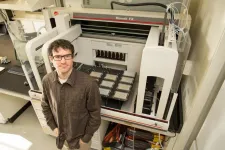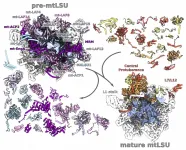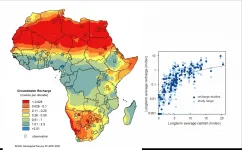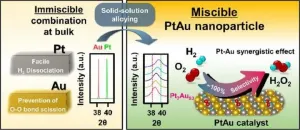Harnessing socially-distant molecular interactions for future computing
Could long-distance interactions between individual molecules forge a new way to compute?
2021-02-16
(Press-News.org) Could long-distance interactions between individual molecules forge a new way to compute?
Interactions between individual molecules on a metal surface extend for surprisingly large distances - up to several nanometers.
A new study, just published, of the changing shape of electronic states induced by these interactions, has potential future application in the use of molecules as individually addressable units.
For example, in a future computer based on this technology, the state of each individual molecule could be controlled, mirroring binary operation of transistors in current computing.
MEASURING SOCIALLY-DISTANT MOLECULAR INTERACTIONS ON A METAL SURFACE
The Monash-University of Melbourne collaboration studied the electronic properties of magnesium phthalocyanine (MgPc) sprinkled on a metal surface.
MgPc is similar to the chlorophyll responsible for photosynthesis.
By careful, atomically-precise scanning probe microscopy measurements, the investigators demonstrated that the quantum mechanical properties of electrons within the molecules - namely their energy and spatial distribution - are significantly affected by the presence of neighbouring molecules.
This effect - in which the underlying metal surface plays a key role - is observed for intermolecular separation distances of several nanometres, significantly larger than expected for this kind of intermolecular interaction.
These insights are expected to inform and drive progress in the development of electronic and optoelectronic solid-state technologies built from molecules, 2D materials and hybrid interfaces.
DIRECTLY OBSERVING CHANGES IN MOLECULAR ORBITAL SYMMETRY AND ENERGY
The phthalocyanine (Pc) 'four leaf clover' ligand, when decorated with a magnesium (Mg) atom at its centre, is part of the chlorophyll pigment responsible for photosynthesis in bio organisms.
Metal-phthalocyanines are exemplary for the tunability of their electronic properties by swapping the central metal atom and peripheral functional groups, and their ability to self-assemble in highly ordered single layers and nanostructures.
Cutting- edge scanning probe microscopy measurements revealed a surprisingly long-range interaction between MgPc molecules adsorbed on a metal surface.
Quantitative analysis of the experimental results and theoretical modelling showed that this interaction was due to mixing between the quantum mechanical orbitals - which determine the spatial distribution of electrons within the molecule - of neighbouring molecules. This molecular orbital mixing leads to significant changes in electron energies and electron distribution symmetries.
The long range of the intermolecular interaction is the result of the adsorption of the molecule on the metal surface, which "spreads" the distribution of the electrons of the molecule.
"We had to push our scanning probe microscope to new limits in terms of spatial resolution and complexity of data acquisition and analysis", says lead author and FLEET member Dr Marina Castelli.
"It was a big shift in thinking to quantify the intermolecular interaction from the point of view of symmetries of spatial distribution of electrons, instead of typical spectroscopic shifts in energy, which can be more subtle and misleading. This was the key insight that got us to the finish line, and also why we think that this effect was not observed previously."
"Importantly, the excellent quantitative agreement between experiment and atomistic DFT theory confirmed the presence of long-range interactions, giving us great confidence in our conclusions", says collaborator Dr Muhammad Usman from the University of Melbourne.
The outcomes of this study can have great implications in the development of future solid-state electronic and optoelectronic technologies based on organic molecules, 2D materials and hybrid interfaces.
INFORMATION:
THE STUDY
"Long-Range Surface-Assisted Molecule-Molecule Hybridization" was published in Small in February 2021. (DOI: 10.1002/smll.202005974)
Researchers at Monash University's School of Physics and Astronomy worked closely with collaborators in the Centre for Quantum Computation & Communication Technology based at the University of Melbourne's School of Physics.
All experiments were performed at Monash University, supported through the Australian Research Council, FLEET Centre of Excellence (CE170100039), and Monash Centre of Atomically Thin Materials (MCATM). Additional support was provided by Dr Schiffrin's ARC Future Fellowship (FT150100426). Numerical simulations were performed at the University of Melbourne, supported by resources provided by the National Computing Infrastructure (NCI) and Pawsey Supercomputing Centre through NCMAS.
SCANNING PROBE MICROSCOPY (SPM) AND FLEET
Dr Schiffrin's group at FLEET uses SPM to investigate the atomic-scale properties - structural and electronic - of new nanomaterials with potential use in future low-energy electronic technologies.
FLEET is an Australian Research Council-funded research centre bringing together over a hundred Australian and international experts to develop a new generation of ultra-low energy electronics.
[Attachments] See images for this press release:
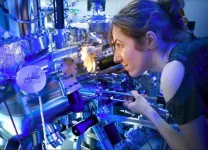
ELSE PRESS RELEASES FROM THIS DATE:
2021-02-16
The placement of a wet cotton pellet against Mineral Trioxide Aggregate (MTA) is often recommended to ensure the completion of its setting reaction. This study aimed to evaluate the setting behaviour of MTA Angelus and NeoMTA by comparing their hardness after placing them in dry and moist conditions.
A simulated open apex was created on 40 polyvinyl tubes. The apical 4 mm of the tubes was filled with the two materials, NeoMTA Plus (Avalon Biomed Inc. Bradenton, FL, USA) and MTA Angelus (Angelus, Londrina, PR, Brazil) (n=20 per group). Both groups were subdivided into two subgroups based on the dry and wet conditions (n=10 per group). A wet cotton pellet was placed above the ...
2021-02-16
The schools in Vietnam observe a phenomenon that almost all parents send their children to school using private vehicles, mostly motorcycles. The parents usually park their vehicle on streets outside the school gates which can cause serious congestion and chances of of traffic accidents.
This study aims to identify the factors affecting the picking up of pupils at primary school by analysing typical primary schools in Hanoi city. The researchers used the binary logistic regression model to determine the factors that influence the decision of picking up pupils and the waiting duration of parents. The behaviour of motorcyclists during the process ...
2021-02-16
If B is better than A, and C is better than B, it follows by the transitive property that C is better than A. And, yet, this is not always the case. Every kid is familiar with the Rock-Paper-Scissors game--the epitome of nontransitivity in which there is no clear hierarchy among the three choices, despite each two-way interaction having a clear winner: Paper beats Rock, Scissors beats Paper, and Rock beats Scissors.
Evolution may be teeming with nontransitive interactions as well. While natural selection - the process by which organisms better adapted to their environments are more likely ...
2021-02-16
A new USC study puts ocean microbes in a new light with important implications for global warming.
The study, published Tuesday in the Proceedings of the National Academy of Sciences, provides a universal accounting method to measure how carbon-based matter accumulates and cycles in the ocean. While competing theories have often been debated, the new computational framework reconciles the differences and explains how oceans regulate organic carbon across time.
Surprisingly, most of the action involving carbon occurs not in the sky but underfoot and undersea. The Earth's plants, ...
2021-02-16
The mitochondrial ribosome is an intricate machine that translates the organellar genome into functional proteins. The formation of the mitochondrial ribosome is a hierarchical process involving dozens of different components. The newly published cryo-EM study by Tobiasson et al in the EMBO Journal characterized a key step in this process.
A complex of 2.2 MegaDalton representing a rare state of assembly of the large subunit was isolated from a model organism Trypanosoma brucei. Since the state was identified in only 3.5 % of the complexes, five cryo-EM datasets had to be collected at the SciLifeLab facility and ESRF in Grenoble and combined together.
The resulting structure revealed ...
2021-02-16
A new study published in Nature Communications suggests that the extinction of North America's largest mammals was not driven by overhunting by rapidly expanding human populations following their entrance into the Americas. Instead, the findings, based on a new statistical modelling approach, suggest that populations of large mammals fluctuated in response to climate change, with drastic decreases of temperatures around 13,000 years ago initiating the decline and extinction of these massive creatures. Still, humans may have been involved in more complex and indirect ways than simple models of overhunting suggest.
Before around 10,000 years ago, North America was ...
2021-02-16
Effective governance and investment decisions need to be informed by reliable data, not only about where groundwater exists, but also the rate at which groundwater is replenished. For the first time using ground measurements, a recent study has quantified groundwater recharge rates across the whole of Africa - averaged over a fifty-year period - which will help to identify the sustainability of water resources for African nations.
The study, led by the British Geological Survey and involving an international team from the UK, South Africa, France, Nigeria, and America, developed a dataset of 134 existing recharge studies ...
2021-02-16
Gender equity and racial diversity in medicine can promote creative solutions to complex health problems and improve the delivery of high-quality care, argue authors in an analysis in CMAJ (Canadian Medical Association Journal).
"[T]here is no excuse for not working to change the climate and environment of the medical profession so that it is welcoming of diversity," writes lead author Dr. Andrea Tricco, Knowledge Translation Program, Unity Health, and the University of Toronto, with coauthors. "The medical profession should be professional, be collegial, show mutual respect, and facilitate the full potential and contribution of all genders, races, ethnicities, religions and nationalities for the benefit of patient ...
2021-02-16
NASA, in collaboration with other leading space agencies, aims to send its first human missions to Mars in the early 2030s, while companies like SpaceX may do so even earlier. Astronauts on Mars will need oxygen, water, food, and other consumables. These will need to be sourced from Mars, because importing them from Earth would be impractical in the long term. In Frontiers in Microbiology, scientists show for the first time that Anabaena cyanobacteria can be grown with only local gases, water, and other nutrients and at low pressure. This makes it much easier to develop sustainable biological life support systems.
"Here we show that cyanobacteria can use gases available in the Martian atmosphere, at a low total pressure, as their source of carbon and nitrogen. Under these conditions, ...
2021-02-16
Hydrogen peroxide is used as a disinfectant, after dilution in water, to treat wounds. It is widely used across the industry as an eco-friendly oxidizing agent for impurity removal from semiconductors, waste treatment, etc. Currently, it is mainly produced by the sequential hydrogenation and oxidation of anthraquinone (AQ). However, this process is not only energy intensive and requires large-scale facilities, but AQ is also toxic.
As an alternative to the AQ process, hydrogen peroxide direct synthesis from hydrogen (H2) and oxygen (O2) using a palladium (Pd) catalyst was proposed. However, the commercialization of the technology ...
LAST 30 PRESS RELEASES:
[Press-News.org] Harnessing socially-distant molecular interactions for future computing
Could long-distance interactions between individual molecules forge a new way to compute?

